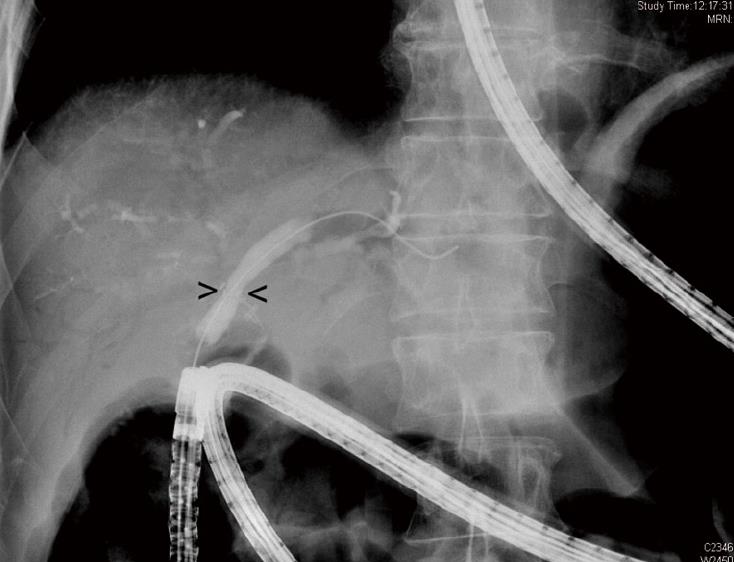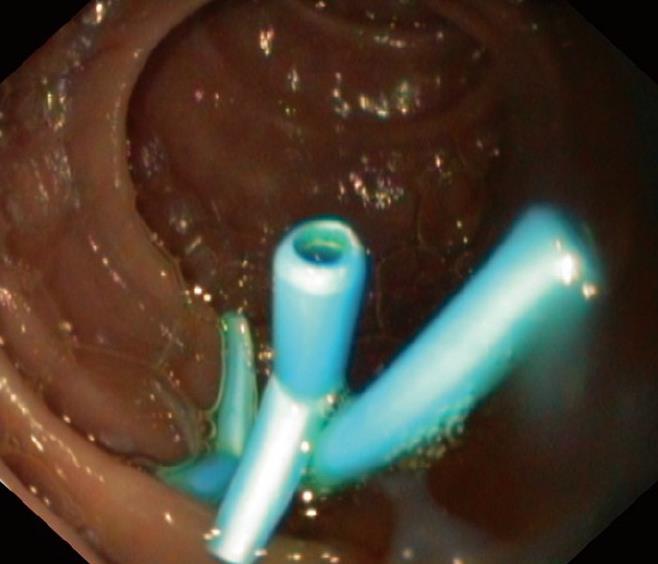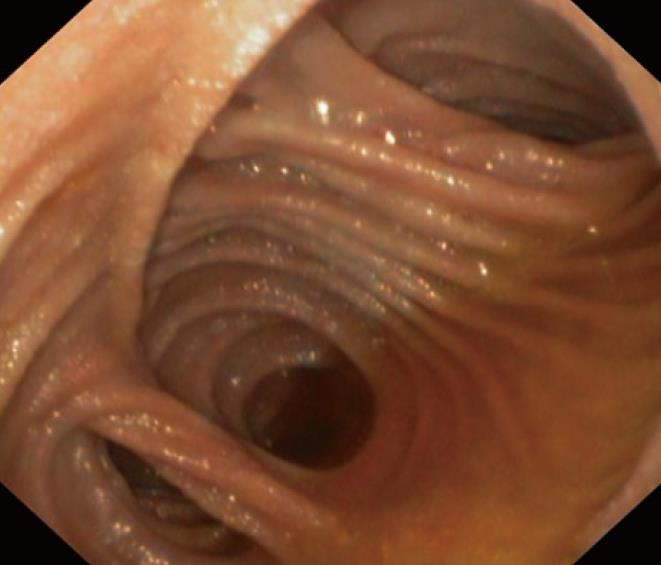Published online Sep 16, 2010. doi: 10.4253/wjge.v2.i9.314
Revised: August 12, 2010
Accepted: August 19, 2010
Published online: September 16, 2010
AIM: To compare the efficacy of double-balloon enteroscopy (DBE) and single-balloon enteroscopy (SBE) in therapeutic endoscopic retrograde cholangiography (ERC) in patients with Roux-en-Y entero-enteric anastomosis.
METHODS: Retrospective analysis of our patient cohort revealed 4 patients with enterobiliary anastomosis and Roux-en-Y entero-enteric anastomosis who underwent repeated ERC with DBE and SBE because of recurrent cholangitis.
RESULTS: A total of 38 endoscopic retrograde cholangiopancreatography procedures were performed in 25 patients with Roux-en-Y entero-enteric anastomosis. DBE was used in 29 procedures and SBE in 9. The 4 patients who underwent repeated ERC with DBE and SBE suffered from recurrent cholangitis due to stenosis of the enterobiliary anastomosis. ERC was performed repeatedly to achieve balloon dilation with/without biliary stone extraction and multiple stent placement at the level of the enterobiliary anastomosis. In all 4 patients DBE and SBE were equally successful. Compared to DBE, SBE was equally effective in passing the Roux-en-Y entero-enteric anastomosis, reaching the enterobiliary anastomosis and performing therapeutic ERC.
CONCLUSION: This retrospective comparison shows that DBE and SBE are equally successful in the performance of therapeutic ERC at the level of the enterobiliary anastomosis after Roux-en-Y entero-enteric anastomosis.
- Citation: Moreels TG, Pelckmans PA. Comparison between double-balloon and single-balloon enteroscopy in therapeutic ERC after Roux-en-Y entero-enteric anastomosis. World J Gastrointest Endosc 2010; 2(9): 314-317
- URL: https://www.wjgnet.com/1948-5190/full/v2/i9/314.htm
- DOI: https://dx.doi.org/10.4253/wjge.v2.i9.314
Roux-en-Y entero-enteric anastomosis of the small bowel is a standard surgical technique for draining the biliary system via an afferent jejunal limb[1]. However, the enterobiliary anastomosis is excluded from conventional endoscopic access. Therefore, biliary complications such as stenosis or stones are often dealt with surgically.
The recently developed technique of balloon-assisted enteroscopy allows deep and even complete intubation of the small bowel[2,3]. Fujinon double-balloon enteroscopy (DBE) has been commercially available since 2003 and Olympus single-balloon enteroscopy (SBE) since 2007. Both types of balloon-assisted enteroscopes also allow intubation of the Roux-en-Y afferent limb to perform endoscopic retrograde cholangiopancreatography (ERCP) although with variable success rates[4-12]. However, due to the complex nature of these procedures, head to head comparison studies of DBE and SBE to perform ERCP after Roux-en-Y is not available.
We present a case series of 4 patients who underwent successful ERC using DBE, and successful repeated ERC using SBE. All procedures were performed because of cholangitis due to stenosis with/without biliary stones at the level of the enterobiliary anastomosis with Roux-en-Y reconstruction. Endoscopic treatment consisted of balloon dilation of the enterobiliary anastomosis and multiple stent placement.
From 2006 to 2009 a total of 25 patients with previous Roux-en-Y reconstruction underwent 38 ERCP procedures using either DBE or SBE. 29 procedures were performed with DBE and 9 with SBE. Retrospective analysis revealed that 4 patients underwent repeated procedures with DBE and SBE, allowing comparison of the two types of enteroscopes in the same patient. The 4 patients had previously undergone hepatobiliary surgery with enterobiliary anastomosis and Roux-en-Y entero-enteric anastomosis. They were referred for ERC because of recurrent cholangitis due to stenosis of the enterobiliary anastomosis. All procedures were performed under general anesthesia with endotracheal tube ventilation and the patient in supine position. Fluoroscopic control was available in all procedures. We used the therapeutic Fujinon DBE EN-450T5 (since 2005) and the Olympus SIF Q180 (since 2009) with a working length of 200 cm and a working channel of 2.8 mm diameter, allowing introduction of all conventional accessory tools and provided the length is at least 230 cm. Both endoscopes are readily available in our endoscopy department and are equally used without preference. Cannullation catheters (PR-Y0001), guidewires (G-Y0001), extraction balloons (B-Y0003) and stent pushers (MAJ-Y0025-1) were Olympus prototypes (Olympus Medical Systems Corp., Japan), dilation balloons were conventional esophageal dilation balloons (CRE Microvasive, Boston Scientific, Ireland), plastic stents were conventional 7 Fr biliary stents (Cook Medical, Ireland). Procedures were performed according with the Helsinki Declaration and all patients signed informed consents.
The first patient was a 73-year old male with a right hepatectomy because of a Klatzkin tumor. An enterobiliary anastomosis was constructed at the level of the left hepatic duct with a Roux-en-Y entero-enteric anastomosis. The patient was referred because of recurrent cholangitis 2 years after surgery. The initial DBE procedure consisted of balloon dilation (6 mm) of the stenotic enterobiliary anastomosis and removal of sludge and biliary stone fragments (Figure 1). Because of recurrent cholangitis a second DBE procedure was performed with placement of 3 biliary 7 Fr stents (Figure 2). Afterwards SBE was used to remove the biliary stents and to perform a control cholangiogram. SBE was fornd to be as effective as DBE for passing the entero-enteric Roux-en-Y anastomosis and proceeding in the afferent limb to reach the enterobiliary anastomosis and then performing ERC.
The second patient was a 62-year old female with a Billroth II gastrectomy and an enterobiliary anastomosis with a Roux-en-Y entero-enteric anastomosis performed because of congenital common bile duct duplication cysts. She suffered from recurrent cholangitis in the left liver lobe. The initial DBE procedure consisted of balloon dilation (7 mm) of the stenotic enterobiliary anastomosis at the level of the left hepatic duct. Three months later a further balloon dilation (8 mm) was performed using the SBE, which was equally effective.
The third patient was a 31-year old female with an enterobiliary anastomosis with a Roux-en-Y entero-enteric anastomosis carried out after complicated cholecystecomy. She was referred for recurrent cholangitis. Initial DBE encountered difficulties in manoeuvring the endoscope beyond the Roux-en-Y anastomosis. However, the stenotic enterobiliary anastomosis was reached, balloon dilation (8 mm) was performed and 3 biliary 7 Fr stents were successfully placed. The stents spontaneously dislocated after 2 wk and 4 mo later a second balloon dilation (8 mm) was performed using the SBE. Similar difficulties in passing the entero-enteric Roux-en-Y anastomosis were encountered.
The last patient was a 71-year old male with a resected Klatzkin tumor with enterobiliary anastomosis and a Roux-en-Y entero-enteric anastomosis. Shortly after the initial surgery, cholangitis with intrahepatic abscess formation occurred. Percutaneous transhepatic cholangiography was performed in order to dilate the stenotic enterobiliary anastomis. This procedure was complicated by a perforation of the anastomosis and intraperitoneal bile leak. The patient was then referred for ERC using DBE. With the DBE the stenotic and inflammatory enterobiliary anastomosis was easily reached. Because of the inflammatory oedema and the recent perforation, no balloon dilation was performed before 2 biliary 7 Fr stents were placed. One mo later cholangitis re-occurred and ERC was repeated, this time using SBE. The stents were occluded and removed. Using an extraction balloon the intrahepatic bile ducts were cleared of sludge. Progressive balloon dilation (8 mm) of the anastomosis was successfully performed.
In order to prevent cholangitis, 3 out of these 4 patients were treated with oral ursodeoxycholic acid on a continuous basis.
The concept of balloon-assisted endoscopy was developed by the Japanese endoscopist Hironori Yamamoto in 2001[2,13]. It was designed for deep and even complete intubation of the small bowel. Nowadays, both DBE and SBE are commercially available. Both techniques have been shown effective to perform ERCP after Roux-en-Y reconstructive surgery of the small bowel[4-12]. However, head to head comparison of DBE and SBE is not available, because of the complex nature of these time-consuming procedures. In the present report we describe a case series of repeated ERC using both DBE and SBE in the same patients. This offers a unique comparative insight into the quality performance of DBE and SBE.
Retrospective analysis of our patient cohort revealed 4 patients who had undergone repeated ERC using both DBE and SBE. They were all patients with a history of hepatobiliary surgery resulting in enterobiliary anastomosis and Roux-en-Y entero-enteric anastomosis. The reason for referral was recurrent cholangitis with/without biliary stones because of stenosis at the level of the anastomosis. Because of the Roux-en-Y entero-enteric anastomosis, ERC with a conventional duodenoscope was not possible.
The balloon-assisted enteroscopy allows deep intubation of the small bowel, and usually successful progression of the endoscope beyond the Roux-en-Y anastomosis into the afferent limb. These are mostly constructed side-to-side, which makes it difficult to differentiate the afferent limb (Figure 3). In our series, DBE and SBE were equally effective in reaching the enterobiliary anastomosis. Apparently, the additional inflatable balloon at the tip of the enteroscope is not a prerequisite for these procedures. In contrast, the balloon-loaded overtube is of great help in allowing the enteroscope to proceed into the small bowel, for straightening the enteroscope into a short position and for keeping the enteroscope in position in front of the enterobiliary anastomosis. However, since both DBE and SBE are forward looking endoscopes without steerable lifting, local control of the accessory ERC material at the level of the enterobiliary anastomosis is less effective as compared to ERC with a conventional side-viewing duodenoscope. In addition, the length of the accessory equipment must exceed 230 cm and the width must be less than 2.8 mm.
Therefore, both DBE and SBE seem to be valuable for therapeutic ERCP in selected patients with postoperative complications which are usually dealt with surgically. However, these procedures are complex and time-consuming and the local control of the accessory equipment is not ideal. Although few data are available on the performance of SBE, the present case series shows equal efficacy of DBE and SBE in performing ERC of the enterobiliary anastomosis with Roux-en-Y entero-enteric anastomosis. However, the small number of subjects precludes clear recommendation of one enteroscope system over the other. Moreover, the potential use of alternative therapeutic methods such as interventional radiology and the newly developed spiral Discovery SB overtube should also be studied in order to determine the optimal procedure for dealing with postoperative biliopancreatic problems in patients with Roux-en-Y entero-enteric anastomosis[13].
Small bowel reconstructive surgery may render parts of the gastrointestinal tract inaccessible for conventional endoscopy techniques. Therefore, postoperative problems occurring in these excluded segments are often dealt with surgically. With the development of balloon-assisted enteroscopy, complete endoscopic visualisation of the small bowel is nowadays feasible. Both double- (DBE) and single-balloon enteroscopy (SBE) are available. However, comparative studies of the two techniques are scarce. We present a case series of 4 patients who underwent repeated therapeutic endoscopic retrograde cholangiography after a Roux-en-Y reconstruction of the small bowel, using both DBE and SBE.
The recently developed balloon-assisted enteroscopy may avoid the need for rescue surgery in case of biliopancreatic problems after Roux-en-Y reconstructive surgery of the small bowel. This is an important endoscopic breakthrough for the therapeutic management of the conventionally inaccessible biliopancreatic ducts.
We illustrate that DBE and SBE have comparable accuracy in performing therapeutic endoscopic retrograde cholangiography after Roux-en-Y reconstruction of the small bowel. Although these are time-consuming and technically challenging procedures, we show that both DBE and SBE may avoid the need for rescue surgery in case of biliary tract obstruction. The fact that DBE and SBE were repeated in the same patients provides a unique comparison, showing the equal accuracy of the two techniques.
We show that DBE and SBE are both suitable for performing ERC after Roux-en-Y reconstruction of the small bowel. This opens the door for new endoscopic indications for balloon-assisted enteroscopy and further development of accessory equipment to perform endoscopic retrograde cholangiopancreatography (ERCP). With the global obesity endemic which is often treated surgically by means of Roux-en-Y gastric bypass, indications for these balloon-assisted ERCP procedures are likely to increase in the future.
Roux-en-Y reconstruction of the small bowel is an often used surgical technique in gastrointestinal oncology surgery, hepatobiliary and pancreatic surgery and bariatric surgery. However, this technique renders specific parts of the gastrointestinal and biliopancreatic tract inaccessible for conventional endoscopy.
The current manuscript illustrates that SBE seems to be as accurate as DBE for performing therapeutic ERC after Roux-en-Y reconstruction. This is a descriptive case series of patients who underwent both procedures successfully. Further comparative studies with larger numbers of patients and procedures are necessary. This manuscript is a first encouraging step towards a larger comparative head-to-head study of the two balloon-assisted enteroscopy techniques.
Peer reviewers: David Friedel, MD, Gastroenterology, Winthrop University Hospital, 222 Station Plaza North, Suite 428, Mineola, NY 11501, United States; C Mel Wilcox, MD, Professor, Director, UAB Division of Gastroenterology and Hepatology, 703 19th Street South, ZRB 633, Birmingham, AL 35294-0007, United States
S- Editor Zhang HN L- Editor Hughes D E- Editor Liu N
| 1. | Haubrich WS. Roux of the Roux-en-Y anastomosis. Gastroenterology. 2004;126:653. |
| 2. | Moreels TG. History of endoscopic devices for the exploration of the small bowel. Acta Gastroenterol Belg. 2009;72:335-337. |
| 3. | Sunada K, Yamamoto H. Double-balloon endoscopy: past, present, and future. J Gastroenterol. 2009;44:1-12. |
| 4. | Moreels TG, Roth B, Vandervliet EJ, Parizel PM, Dutré J, Pelckmans PA. The use of the double-balloon enteroscope for endoscopic retrograde cholangiopancreatography and biliary stent placement after Roux-en-Y hepaticojejunostomy. Endoscopy. 2007;39:E196-E197. |
| 5. | Emmet DS, Mallat DB. Double-balloon ERCP in patients who have undergone Roux-en-Y surgery: a case series. Gastrointest Endosc. 2007;66:1038-1041. |
| 6. | Haber GB. Double balloon endoscopy for pancreatic and biliary access in altered anatomy. Gastrointest Endosc. 2007;66:S47-S50. |
| 7. | Aabakken L, Bretthauer M, Line PD. Double-balloon enteroscopy for endoscopic retrograde cholangiography inpatients with a Roux-en-Y anastomosis. Endoscopy. 2007;39:1068-1071. |
| 8. | Mönkemüller K, Bellutti M, Neumann H, Malfertheimer P. Therapeutic ERCP with the double-balloon enteroscope in patients with Roux-en-Y anastomosis. Gastrointest Endosc. 2008;67:992-996. |
| 9. | Koornstra JJ. Double balloon enteroscopy for endoscopic cholangiopancreaticography after Roux-en-Y reconstruction: case series and review of the literature. Neth J Med. 2008;66:275-279. |
| 10. | Neumann H, Fry LC, Meyer F, Malfertheiner P, Mönkemüller K. Endoscopic retrograde cholangiopancreatography using the single balloon enteroscope technique in patients with Roux-en-Y anastomosis. Digestion. 2009;80:52-57. |
| 11. | Itoi T, Ishii K, Sofuni A, Itokowa T, Kurihara T, Tsuji S, Ikeuchi N, Umeda J, Moriyasu F. Single-balloon enteroscopy-assisted ERCP in patients with Billroth II gastrectomy or Roux-en-Y anastomosis. Am J Gastroenterol. 2010;105:93-99. |
| 12. | Moreels TG, Hubens GJ, Ysebaert DK, Op de Beeck B, Pelckmans PA. Diagnostic and therapeutic double-balloon enteroscopy after small bowel Roux-en-Y reconstructive surgery. Digestion. 2009;80:141-147. |
| 13. | Yamamoto H, Sekine Y, Sato Y, Higashizawa T, Miyata T, Iino S, Ido K, Sugano K. Total enteroscopy with a nonsurgical steerable double-balloon method. Gastrointest Endosc. 2001;53:216-220. |
| 14. | Wilkinson M, Nagula S, Buscaglia JM. Spiral enteroscopy-assisted pancreatoscopy for the diagnosis of obscure overt bleeding in a patient with surgically altered anatomy. Gastrointest Endosc. 2010;72:653-655. |















